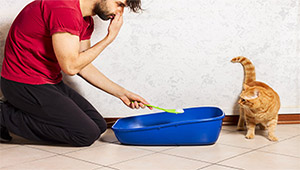Cat litter is the basic need of your cat litter box, but most of the owners wonder if it is harmful to humans? Is it all toxic? These are all the common questions that every cat owner has in his/her mind.
Cat litter is usually not harmful to humans, but some ways of using it may be dangerous for you. Before going deep into the topic, remember that cat litters are available in different types. You have to choose the right one.
Related Topics You Might Like:
Products Related To Topic
"(Paid Links)" ▶ As an Amazon Associate, We earn from qualifying purchases.
Is Cat Litter Harmful to People?
No. Cat litter is not dangerous or toxic to humans itself. Until the product is contaminated with feces or urine, it is not a biohazard.
Types of litter

Clumping Litter
For many pet owners, clumping cat litter is a popular option. Cleaning up clumping litter is usually more accessible and less messy than cleaning up non-clumping debris. And spending less time cleaning means spending more time with your cute kitten.
Litter That Doesn't Clump
Clay is commonly used in non-clumping litter box solutions. When opposed to sand or conventional dirt, one of the benefits of non-clumping litter is its capacity to absorb many fluids. Long before the clumping formula was discovered, this was the original sort of commercial cat litter.
Crystal Litter Made of Silica
It is made up of microscopic white particles of silicon dioxide. Silicon is a very absorbent material. Therefore pee soaks up a lot of it.

How different types of litter affect the humans?
Clumping litter is a natural product made up of bentonite, which is the component that permits liquids to clump together. It's better not to consume or inhale this material. Clumping litter may also contain crystalline silicate dust, classified as a carcinogen by California and can cause cancer. In addition, the inhalation of silica can raise the risk of lung cancer. On the other hand, many cat litter makers employ sodium silicate sand, which is non-toxic to our feline friends.
Overall, experts agree that you should avoid breathing clumping litter. In addition, many shelters avoid clumping litter. Clay is a natural substance, but that doesn't mean much when it comes to safety concerns. On the other hand, Clay appears to be a better alternative for anyone concerned about health issues, as it is less "powdery" than clumping litter. This form of trash is just less likely to be inhaled or ingested. The eyes and lungs might be irritated by silicon dioxide. Cat owners and the felines themselves are only exposed to trace levels of the drug, making it safe to use.

Cat Litter Dust's Hazards
When cat litter is moved, it produces cat litter dust. Dust isn't an ingredient; it's created when trash particles collide in transit. A kitten or animal that is near to the ground is more likely to inhale small particles.

